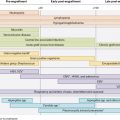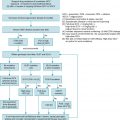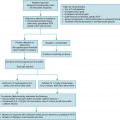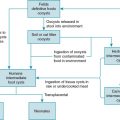Solid organ transplantation (SOT) has transformed the prognosis of many children with organ failure. An estimated 135,860 SOTs were performed worldwide in 2016. A total of 33,610 SOTs were performed in the United States, with children, the majority of whom were younger than 10 years, receiving 1878 of these transplants. , Despite advances in the field of transplantation, infections remain an important cause of morbidity and mortality in pediatric SOT recipients. Refinements in immunosuppressive regimens have led to the reduction of graft rejection episodes and prolonged graft and patient survival. However, the evolving armamentarium of immunosuppressive agents with differing mechanisms of actions on distinct components of the immune system has also contributed to the risk for and modified the clinical manifestations of transplant-related infections. Indeed, the clinical diagnosis of infection in an SOT recipient may be complicated by lack of signs of inflammation, and conversely, transplant-associated entities, such as graft rejection, may mimic infection. As the number of pediatric SOTs increases, it is important for pediatric providers to have knowledge of the risk factors for infection after SOT and use optimal prevention strategies.
The risk for infection is determined by the interplay of multiple factors before and after SOT, including the epidemiologic exposures and underlying conditions of both the recipient and donor, the type of transplanted graft and its associated immunosuppressive regimen, and the recipient’s overall “net state of immunosuppression,” which is defined by transplant, host, and pathogen-specific factors. Young age at the time of SOT is an important variable that influences infection risk and type; it follows that younger patients are less likely to have encountered certain pathogens and thus lack immunity, but they are at high risk of developing infection from the donor or acquiring primary infection after SOT while receiving immunosuppression. Furthermore, the extent to which immunosuppressive regimens affect the developing immune system in children who require SOT in infancy has not been fully elucidated. The risk of infection and type of pathogen is also dependent on time elapsed since SOT; the greater the immune dysfunction, the greater the predisposition to infection and to severe disease. In this chapter we review the multiple preventative strategies that may be used to help mitigate the risk of infection after SOT.
Pretransplant evaluation
The pretransplant evaluation of the candidate is essential in informing strategies to prevent infections after SOT (see Chapter 4 ). It screens transplant candidates for infections that may preclude transplant, identifies active infections that require treatment before proceeding with SOT, and determines the risk of latent infections that may require antimicrobial therapy or will dictate posttransplant monitoring. The pretransplant evaluation allows for the identification of unique exposures or risk factors for pathogens that cause opportunistic infections but are not routinely tested for, including certain parasites, arboviruses, and endemic fungi. This period is also the optimal time to provide vaccination to SOT candidates to increase their likelihood of adequate immunogenicity before receiving immunosuppressive agents, as well as vaccinating the child’s household contacts (see Chapter 9 ). Lastly, patients and families should be counseled regarding strategies for safe living that can limit or at least reduce the risk of epidemiologic exposures to potential infections (see Chapter 13 ).
The pretransplant evaluation of the donor (see Chapter 5 ) identifies both latent and active infections that pose a risk of transmission to the organ recipient and guides monitoring and preventive strategies for the recipient after transplant. Unexpected transmission of infections from donors to pediatric recipients is infrequent and is associated with an attributable mortality rate of less than 1%. Determination of risk factors for the designation of increased risk donor for human immunodeficiency virus, hepatitis B, and hepatitis C is important for informed decisions regarding use of those donor organs and posttransplant monitoring of the recipient. ,
Vaccination
Pediatric patients remain at risk for vaccine-preventable infections before and after SOT. , Current guidelines provide a context for vaccination that emphasizes the importance of optimizing vaccination before SOT and completing or reimmunizing after SOT in the setting of ongoing immunosuppression. , This may include an accelerated immunization schedule before transplant, according to the Centers for Disease Control guidelines. The safety and immunogenicity of live virus vaccination in select SOT recipients is an area of ongoing study. Immunizations before and after SOT are covered in detail in Chapter 9 .
Perioperative antimicrobial prophylaxis
In the first 30 days after SOT, infections related to the duration and complexity of the surgery and possible complications, the presence of devices, and the disruption of mucocutaneous barrier integrity are most frequent. In pediatric recipients, receipt of organs from adult donors causes a size discrepancy that may lead to an increased infectious risk from anastomotic complications or need for delayed abdominal or thoracic closure. , Implementation of infection control practices, including bundles to prevent surgical site infections, central line–associated bloodstream infections, urinary tract infections, and other health care–associated infections minimize potential risks.
Perioperative antibiotic prophylaxis is guided by the organ being transplanted and is considered the standard of care to prevent postoperative surgical site infections, which occur in 3% to 53% of SOT recipients. , Prophylaxis strategies need to take into account the incidence and local institutional epidemiology and susceptibility profiles of certain pathogens to inform patient management. General prophylaxis principles of using the narrowest, most efficacious agent for the shortest duration (24 to 48 hours) and optimizing pharmacokinetics/pharmacodynamics perioperatively should be used; however, there is a paucity of controlled evidence to guide optimal choice of antimicrobial and duration of prophylaxis. Additionally, much of the evidence is derived from adult studies and guidelines, which are limited with regard to pediatric-specific recommendations. The epidemiology and certain risk factors identified in adults may indeed be distinct in children given the differences in underlying conditions that caused organ dysfunction. Thus additional pediatric studies with robust methodologies and sufficient sample size are needed to confirm or revoke whether adult data should continue to be extrapolated to the management of pediatric SOT recipients. Lastly, certain scenarios may warrant modification of perioperative antimicrobial regimens. For example, in transplant candidates with a ventricular assist device or those with active bacteremia or candidemia who are receiving extracorporeal membrane oxygenation, the perioperative antimicrobial regimen should include coverage for the pathogen. Adjustments based on the pretransplant colonization status of the recipient may also be warranted when there is concern that bacteria or fungi may seed vascular suture lines, lead to loss of integrity at the graft anastomosis site, and cause direct damage to the allograft. For example, in pediatric lung transplantation when a frequent indication for transplantation may be cystic fibrosis, pretransplant colonization in the recipient should be considered when choosing the perioperative antimicrobial prophylaxis, although optimal type and duration of prophylaxis is unknown. Finally, infections identified in the donor should also be considered when choosing appropriate perioperative antimicrobial agents.
When broadening the antimicrobial spectrum or prolonging duration of prophylaxis, consideration is needed regarding possible adverse effects, including the risk of contributing to the development of multidrug-resistant organisms (MDROs). The increasing burden of MDROs causing colonization and infection in the donor graft or recipient is an emerging challenge in SOT, and additional pediatric-specific data are needed to establish optimal management schemes (see Chapter 14 ). A robust institutional antibiotic stewardship program is vital in MDRO prevention (see Chapter 11 ). Whether the performance of active culture surveillance around the time of SOT on donors or candidate should be performed to inform prophylaxis is unclear; however, results of testing in adult SOT recipients have served to intensify infection control practices and decrease transmission risk. , Indeed, infection prevention practices are critical in preventing health care–associated infections in this vulnerable population (see Chapter 12 ).
Posttransplant prophylaxis and monitoring
Ongoing antibiotic prophylaxis may be warranted after SOT in certain recipients. For example, in renal transplant recipients trimethoprim-sulfamethoxazole may be used for urinary tract infection prophylaxis. Results of pretransplant serologic testing in both the donor and recipient for herpesviruses that establish latency, including cytomegalovirus, Epstein-Barr virus, and Herpes Simplex Virus, are important determinants of individual risk for infection after SOT and help guide posttransplant interventions. The interpretation of serologic testing in infant SOT candidates younger than 12 months is challenging. A false-positive result may reflect passive transfer of maternal antibodies or receipt of immunoglobulin or blood products. Thus, young infants should be stratified to the highest risk category. Young children are more likely to be naïve for these herpesviruses and so, upon receipt of a graft from a seropositive donor, are more likely to develop a primary infection with the associated complications. Viral prophylaxis strategies, preemptive treatment, and monitoring parameters are discussed and vary by institution depending on the organ transplanted, virus, and serological status of the donor and recipient. Virus-specific immunologic monitoring assays hold promise in quantitatively and functionally interrogating the adaptive immune system and informing prophylaxis management in adults; however, additional pediatric data are needed to determine their utility in clinical practice. Molecular-based screening of potential increased risk donors for human immunodeficiency virus, hepatitis B, and hepatitis C has the potential to reduce, but does not completely eliminate, the risk of donor-derived transmission of these infections.
The prevention of other infections, including Toxoplasma , Pneumocystis jirovecii , mycobacterial, and fungal infections, are discussed in detail in the relevant chapters. The type of prophylaxis, duration, and monitoring are determined by type of organ transplanted, pretransplant donor and recipient screening, and relevant geographic exposure. It is important to note that the contemporary epidemiology of infections—for example. P. jirovecii pneumonia and cytomegalovirus—highlight the fact that prophylaxis strategies may modify the epidemiology and delay timing of infections after SOT, but they may not completely eliminate the risk of infection. , Lastly, prophylaxis strategies may need to be revised or reimplemented in the post-SOT period in response to therapies directed at graft rejection.
Adjunctive therapies may be used in an effort to reduce infection risk after SOT. Hypogammaglobulinemia after SOT has been associated with an increased risk of infections, particularly when total immunoglobulin G concentrations are less than 400 mg/dL. However, whether immunoglobulin replacement mitigates this risk and leads to improved patient outcomes is less clear. Pediatric SOT recipients are at risk for community-acquired respiratory viruses with associated complications, particularly with exposure to other young children, day care, and school. With the exception of administering an annual inactivated influenza vaccine and using respiratory syncytial virus−specific humanized monoclonal antibody palivizumab for prophylaxis in select children younger than 24 months who will be profoundly immunocompromised during the respiratory syncytial virus season, prevention consists of good hand hygiene and awareness of safe living after transplant (see Chapter 13 ).
Summary
The risk of infection peri- and post-SOT is a dynamic continuum that is dependent on multiple factors related to the child and donor, transplantation, immunosuppressive regimens, and epidemiologic exposures. Knowledge of these factors allows for the application of multiple preventative strategies, including antimicrobial prophylaxis, surveillance schemes, infection control, stewardship, and vaccination efforts that allow for mitigation, but not complete elimination of the infectious risk. Additional pediatric data are needed to optimize these preventative strategies in children after SOT.
References
Stay updated, free articles. Join our Telegram channel

Full access? Get Clinical Tree








